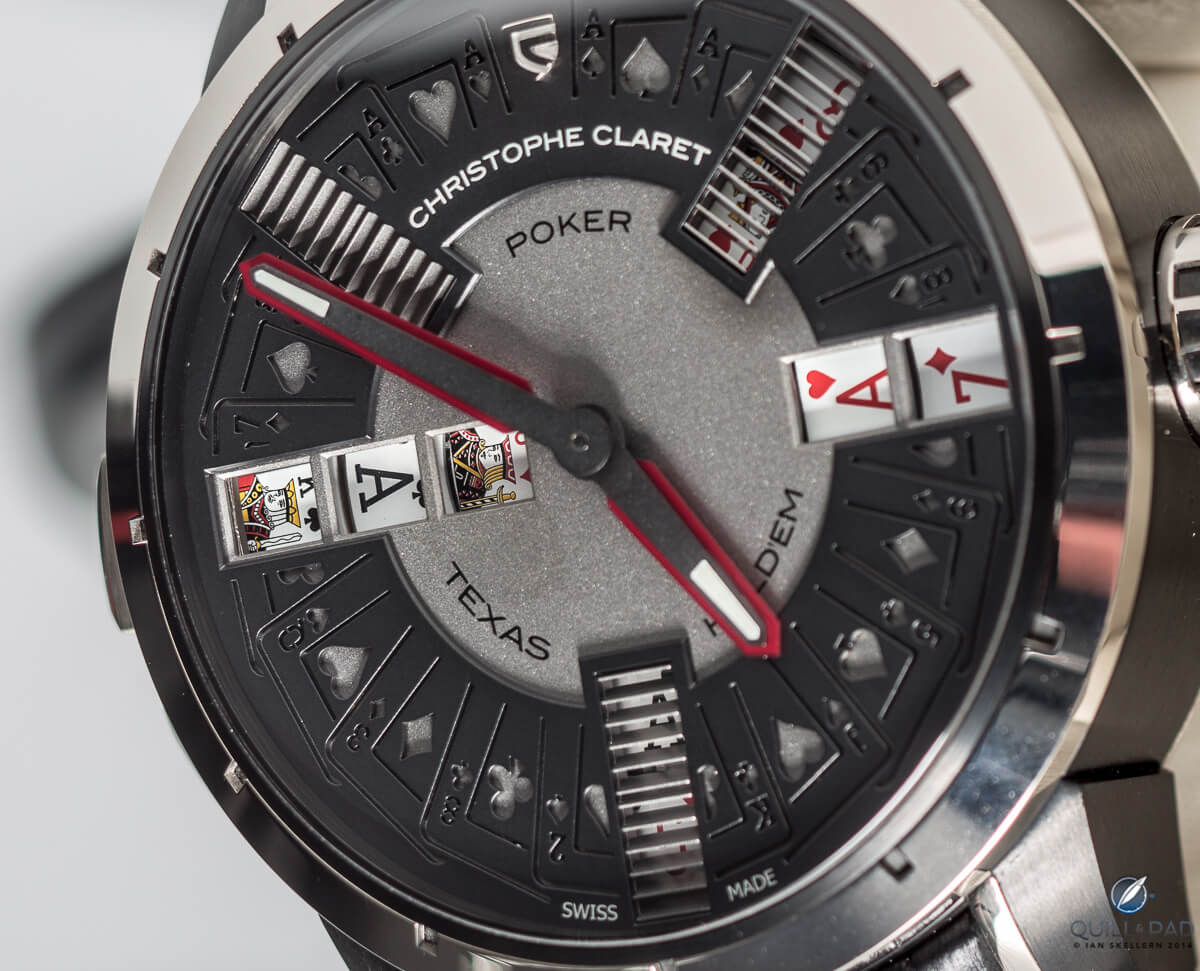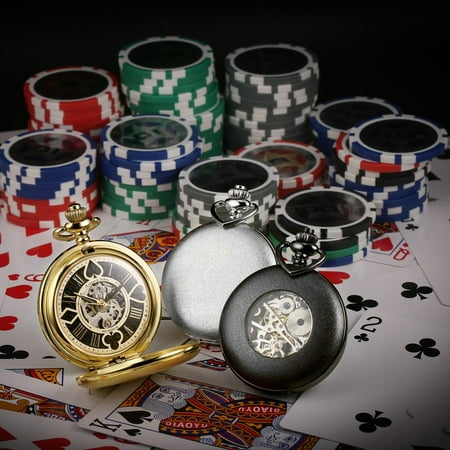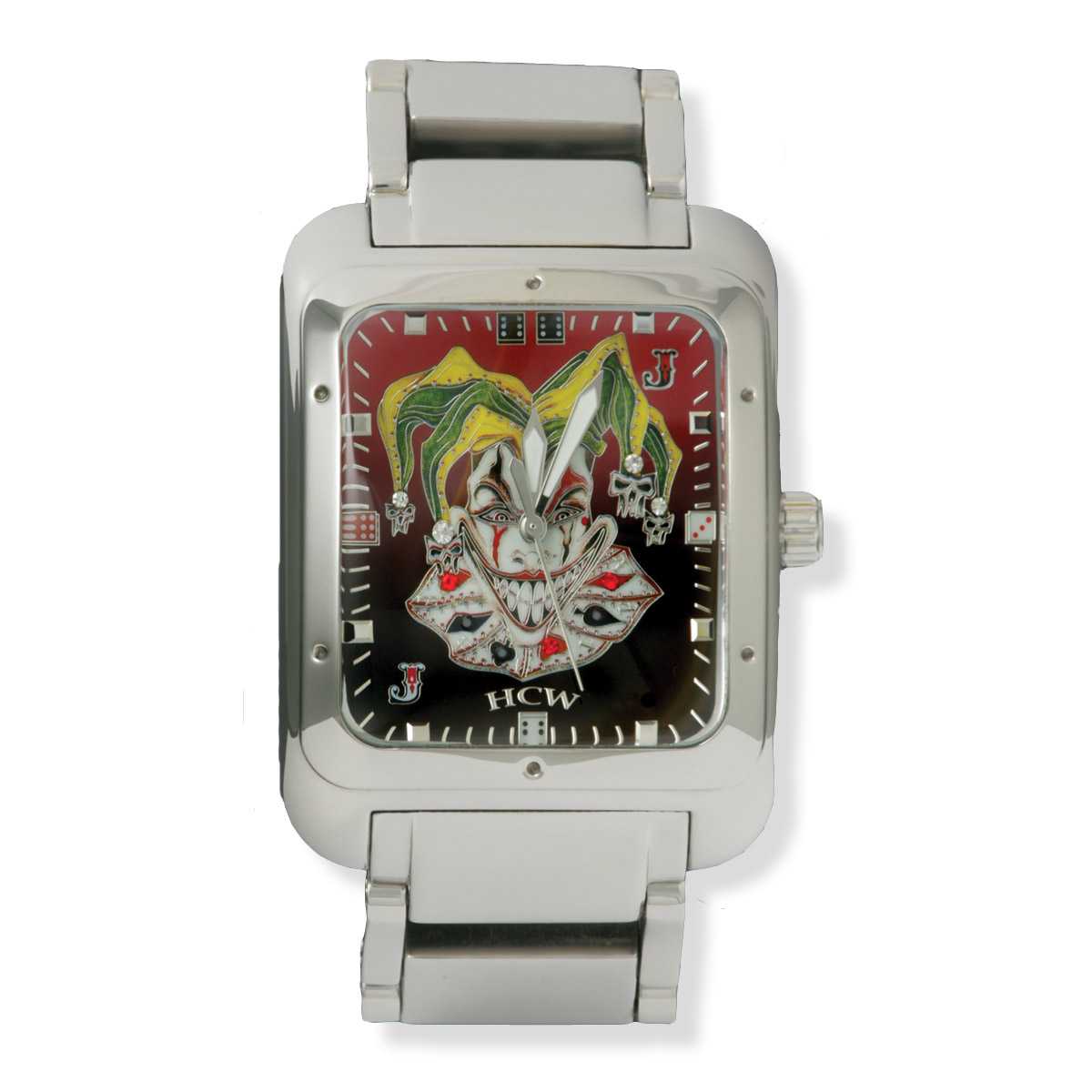Poker Watch Dial
Dial Styles, Ornate Dials, Railroad Dials, and Hamilton Melamine Dials
I have a 16S Ilinois poker dial watch. It has a 17J ADJ 3finger Bridge gold set jewel ser# 3368920. The movement was damaged by peening over one of the jewell setting. I would like to replace this movement or replace the watch, with a 16 or 18 size. I think this movement is not uncommon so a. Even though the watch dial is skeletonized in order to view the movement, the red color helps the Hublot Big Bang Unico World Poker Tour watch to be surprisingly legible. I feel like I need to wear one of those shiny blazers to really pull of this watch. Outside of performers in Las Vegas, who can get away with wearing those?
In the second part of our discussion about pocket watch dials, we'll learn about some of the many different styles of dials that were produced and some special dials that were made for use on railroad watches. We'll also take a look at dials produced for use in the Canadian Railway Service.
Dial Styles

Dials were produced in a huge variety of styles, ranging from the very simple to the very ornate. While dials could be painted with either Roman or Arabic numerals, simple Arabic numbers were preferred for railroad watches. Some 'fancy' dials were beautiful works of art and were ornately decorated with painted or fired-on pastoral scenes or other embellishments. Subtle coloration and gold-inlay could be used to decorate a dial as shown below.
Poker Watch Dogs

Top: Elgin enamel dial, multi-colored with inlaid gold leaf.
Middle: American Waltham enamel dial with inlaid gold leaf
Bottom: Illinois Watch Co, multi-colored with fired-enamel floral design and hand-painted gold leaf.
Railroad Watch Dials
Dials approved for use on the railroads tended to be simple and readable. The emphasis was on functionality and readability, even under adverse conditions, so ornate and fancy dials with elegant lettering and scenic backgrounds were NOT typically used by real railroaders who preferred bold, black numerals on a white background.
Some dials were specially produced and patented for railroad service. The Montgomery Safety Dial was invented by Henry S. Montgomery, the General Watch and Clock Inspector from 1896 to 1923 for the Santa Fe Railway. The Montgomery Dial, sometimes called a 'Monty Dial' by collectors, featured an outer track with individual minutes numbered from 1 to 60. The dial first appeared around 1904, and was used across the entire Santa Fe Railway system to help ensure the safety of Santa Fe crew members and passengers. Santa Fe used mercury-pendulum regulators at all crew change points across the system for crewmen to set their pocket watches, and the Montgomery Safety Dial helped to ensure accurate time readings. A 'true' Montgomery dial has the '6' inside the seconds bit, but collectors commonly refer to any dial with the outer 1-60 markers as a Montgomery dial.
Another dial which gained less popularity than the Montgomery was the Ferguson dial, which featured large black Arabic numerals at the 5 minute marks on the main chapter ring, and an inner chapter ring printed in red that numbered the hours 1 through 12. Genuine Ferguson dials are quite rare, so beware of reproductions.
Left: Montgomery Safety Dial, Right: Ferguson Dial
Canadian Railroad Dials
Vintage watch dials produced for Canadian rail service were often marked with a second set of hour markers inside the first. The outer chapter-ring was marked 1 through 12 in the usual way, and the inner ring was marked 13 through 24.
Canadian railroad dials produced for Waltham, Elgin and Rockford railroad watches.
The clean, arabic 'boxcar' style dial (center) would have been the most desirable for railway service.
The Rockford dial is a 'Moorhouse Style' with outer red 5-minute marks.
'Reverse-Canadian' Dial
Here's an unusual variant... we've only seen a couple of these which we have dubbed a 'Reverse Canadian' dial. Maybe we should call it a 'Naidanac' dial? The main outer chapter ring has the numbers 13 through 24, while the inner smaller chapter ring shows 1 through 12.
Hamilton 'Enameline' Dials
The Hamilton Watch Company, in their never-ending quest to be an innovator in watch manufacturing, began making dials out of Melamine plastic in the 50's. This was the 'age of plastics' and melamine was a revolutionary new manufacturing material! Hamilton called this new dial material 'Enameline,' and used it on some of their nicest watches; in particular on many production runs of the 992B Railway Special.
Alas... enameline turned out to be a lousy material for watch dials, as the multi-layer plastic dials have not aged well. Over time the top layer on these dials can develop a spider-web of cracks, often starting at the center, which will continue to deteriorate. In severe cases, the cracks in the dial can become so pronounced that they can interfere with the smooth travel of the hands (particularly the seconds hand).
Unfortunately, there are no suitable replacements available for these cracked Enameline dials. This has created a real dilemma for watchmakers and collectors. Because so many of these dials had problems, any old-stock enamel replacement dials which once existed have been exhausted long ago, so it's basically impossible to find an original replacement dial for a 992B these days (unless you just happen to get lucky). We've seen crudely made replacement dials offered on online auction sites, but most of these are just an ink-jet printed sticker applied over another dial or piece of metal in order to simulate an original dial. We continue to search for a better alternative to offer our customers, but have not yet found a good long-term solution to the Enameline dial problem.
Left: Enameline dial in good condition. Middle: Enameline dial starting to develop cracks. Right: Enameline dial with severe cracks; no longer usable.
The Right Dial Can Make a Difference!
Having the correct dial on a particular watch, or having a rare or unusual dial, can sometimes make a big difference in the value collectors assign to a particular watch. Here's an example: You could add about $1000 to the price-tag of an Illinois Bunn Special, 23-jewel, marked '60-hour' on the watch movement, if it also has a Montgomery dial that is signed ' 23-Jewel 60-Hour' like the NOS example shown below. Another good example... a Hamilton 950B with a mint-condition dial that says '23J Railway Special' can add $500 to the purchase price. Not all watch dials are this rare, of course, but finding the right dial on the right watch is something every collector should keep in mind when hunting for those 'hidden treasures'.
Rare Illinois Bunn Special 23-Jewel 60-Hour Montgomery Dial.
Replacing Damaged Pocket Watch Dials
We are often asked whether replacements are available for damaged enamel dials, and the answer is: usually not, but it depends on the watch and the dial. There are no current manufacturers of pocketwatch dials, and finding old-stock replacement pocketwatch dials can be a real challenge. If your goal is to find a particular dial style to fit a particular watch, you could be searching for a very long time. For more common watches with higher production quantities, like Waltham and Elgin and Illinois and Hamilton (for example), old-stock dials can sometimes be located to replace a damaged dial, but it's definitely hit or miss. We have a large inventory of NOS and used vintage dials, so check with us if you're looking for a particular dial... we might just have what you need.
Stock No. 1485
Henry Perry
London, c1700
Silver pair cases, 54mm
Verge escapement

Price £2750
A fine, early London verge.
MOVEMENT : Gilt verge movement, the engraved and pierced winged balance cock with wide ‘D’ shaped foot. Four crested Egyptian pillars, silver regulator disk and blued screws.
Running well, and in good condition throughout except for one of the pillars which is missing the top section. Fortunately this damage does not effect the running of the watch.
Signed “HEN PERRY, St. ANNs, SOHO, LONDON” and numbered (319).
Poker Watch Dial Watch
DIAL : Silver champleve dial, in good condition. Signed “PERRY, LONDON” on the central disc.
There is just one small hole on the left hand edge of this central disc.
Good early 18th century steel beetle and poker hands.
INNER CASE : Silver, with no hallmarks, but maker’s mark CW and movement serial number (319).
Poker Watch Dial Watches
In very good condition throughout. The hinge is fine and the bezel snaps shut correctly. The high dome crystal is fine.
OUTER CASE : Silver pair case, with matching marks to the inner.
In very good condition throughout. The hinge, catch button and catch are fine and the case closes correctly. There is an old (and small) repair to the centre of the back which obscures the last digit of the serial number.
Henry Parry is listed in Soho, London from 1691, and in the Clockmakers’ Company until 1721.
Poker Watch Dial Online
The case maker is either Cuthbert Weaver or Clay Whitton.